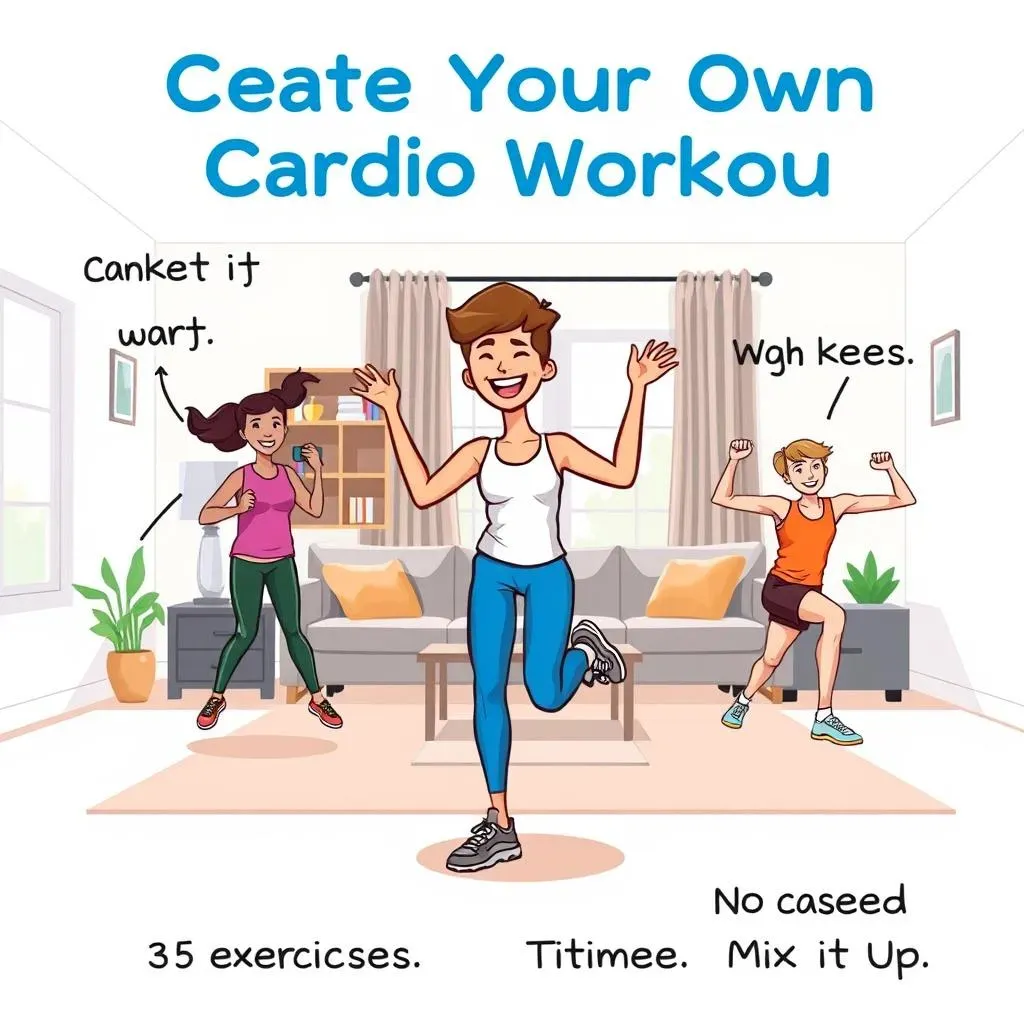Table of Contents
Let's be honest, sometimes hitting the gym feels like a chore. Between the commute, the membership fees, and the crowds, it can be a real drag. But what if I told you achieving a killer cardio workout is totally possible, right in the comfort of your own home? No fancy equipment, no expensive memberships, just you and your body. This article is your ultimate guide to effective cardio workouts at home without equipment. We'll cover a range of exercises suitable for all fitness levels, from beginner-friendly moves to more challenging routines for seasoned athletes. Whether you're aiming to boost your cardiovascular health, shed some extra pounds, or simply add some pep to your step, we've got you covered. We'll break down the best cardio workouts at home without equipment, categorized for easy navigation. First, we'll explore beginner-friendly routines to build a solid foundation. Then, we'll progress to intermediate and advanced levels, introducing progressively more challenging exercises. Finally, we'll teach you how to design your own personalized cardio workouts at home without equipment, so you can keep things exciting and challenging. Get ready to discover a world of fitness possibilities, all within the four walls of your home. Let's get started on your journey to a healthier, fitter you with these amazing cardio workouts at home without equipment!
Best Cardio Workouts at Home Without Equipment for Beginners
So, you're ready to jump into the world of at-home cardio, huh? Awesome! Let's start with the basics. Think of this as your fitness foundation. We're building strength and endurance, getting your heart pumping without needing anything fancy. Jumping jacks are your best friend here. They're simple, effective, and a total body blast! Aim for three sets of 30 seconds, with short rests in between. Need a little more oomph? Add high knees! Bring those knees up high, like you're trying to touch your chest – really get that heart rate up. Three sets of 30 seconds is a great starting point. Remember, consistency is key! Even 10-15 minutes a day will make a huge difference.
Next up: marching in place. Sounds boring, right? Wrong! It's surprisingly effective, especially when you add arm movements. Pump those arms, swing them high, and really get that blood flowing. If you're finding it too easy, try adding some "power punches" to the mix. Imagine you're a boxer, throwing punches with each step. Three sets of 30 seconds each, again with short breaks. Remember to listen to your body; if anything feels uncomfortable, ease up. Want even more low-impact options? Check out our guide to low-impact home cardio for more ideas.
Exercise | Sets | Reps/Duration | Rest |
|---|---|---|---|
Jumping Jacks | 3 | 30 seconds | 15 seconds |
High Knees | 3 | 30 seconds | 15 seconds |
Marching in Place | 3 | 30 seconds | 15 seconds |
Don't forget to warm up before you start. A few minutes of light stretching will help prepare your muscles and prevent injury. And always cool down afterward with some gentle stretching. This helps your body recover and reduces soreness. Remember, consistency is key! Starting small is totally fine. Even a few minutes a day is better than nothing. Gradually increase the intensity and duration as you get fitter. Before you know it, you'll be a cardio pro!
Feeling like you need a little more guidance? We've got you! Check out our beginner cardio guide for more detailed routines and tips.
- Listen to your body. Rest when you need to.
- Start small and gradually increase the intensity.
- Stay hydrated. Drink plenty of water before, during, and after your workout.
Intermediate Cardio Workouts at Home: No Equipment Needed

Intermediate Cardio Workouts at Home: No Equipment Needed
Okay, you've mastered the basics – now let's crank things up a notch! We're moving beyond simple exercises and diving into routines that'll really challenge your cardiovascular system. Burpees are your new best friend. These are a full-body blast, combining squats, push-ups, and jumps. Start with three sets of 10, taking short breaks between each set. Need to modify? Do a step-out burpee, stepping your feet out and back instead of jumping. Remember, proper form is crucial to avoid injury, so watch videos and focus on doing it right, not fast. Feeling ambitious? Add in mountain climbers! Start in a plank position, and then bring your knees towards your chest, alternating legs. Three sets of 30 seconds will leave you breathless! Remember to breathe deeply and focus on your form.
- Burpees (3 sets of 10)
- Mountain Climbers (3 sets of 30 seconds)
- Jumping Jacks (3 sets of 45 seconds)
- High Knees (3 sets of 45 seconds)
Adding intensity is all about pushing your limits. Don't be afraid to increase the number of reps or sets, or shorten your rest periods. If you find yourself plateauing, consider incorporating more advanced variations of the exercises. For example, instead of regular jumping jacks, try adding a lateral hop to each jump. Or try adding a plyometric push-up to your burpees for an extra challenge. Remember to track your progress! Note how many reps you can do, how long you can maintain the exercise, and how you feel afterward. This will help you monitor your improvement and stay motivated. Feeling stuck? Check out these extra tips on low impact cardio to add to your routine.
Exercise | Sets | Reps/Duration | Rest |
|---|---|---|---|
Burpees | 3 | 10-15 reps | 30 seconds |
Mountain Climbers | 3 | 30-45 seconds | 30 seconds |
Jumping Jacks | 3 | 45 seconds | 30 seconds |
High Knees | 3 | 45 seconds | 30 seconds |
Remember, consistency is key! Even a few minutes a day is better than nothing, and this is especially true for intermediate workouts. Start small, and gradually increase the difficulty. Remember to listen to your body, and rest when you need to. And don't forget to stay hydrated! Drinking plenty of water before, during, and after your workout will help you perform better and recover faster. For more structured beginner routines, check out our guide to beginner cardio workouts.
Advanced Cardio Workouts at Home Without Equipment: Level Up Your Fitness

Advanced Cardio Workouts at Home Without Equipment: Level Up Your Fitness
Plyometrics: Jumping into a Higher Level
Alright, champ, you're ready for some serious cardio. We're talking plyometrics—explosive movements that build power and boost your heart rate like crazy. Think jump squats: start in a squat position, then explode upwards, aiming for maximum height. Three sets of 10-12 reps will have you feeling the burn. Need a modification? Try step-ups – stepping onto a sturdy surface (like a chair) and then stepping back down. Focus on controlled movements and a powerful push-off. Three sets of 15 reps per leg. Remember proper form is key here; bad form leads to injuries, and nobody wants that! Listen to your body, take breaks when you need them, and don't push yourself too hard, especially in the beginning. Want to explore more low-impact options? Check out our guide to low-impact cardio workouts to complement your high-intensity training.
Remember to warm up properly before attempting plyometric exercises. A quick jog in place, some dynamic stretches, and a few jumping jacks will prepare your muscles for the intense work ahead. Also, ensure you have enough space around you to avoid any accidents. Always land softly to minimize the impact on your joints. As you progress, consider adding variations to your plyometric exercises to keep things challenging and engaging. For example, you can try adding a jump at the peak of your jump squat or incorporating lateral jumps into your routine. Tracking your progress helps you stay motivated; note the number of reps, sets, and how you feel afterward. This will help you see how far you've come and what you can achieve.
Exercise | Sets | Reps/Duration | Rest |
|---|---|---|---|
Jump Squats | 3 | 10-12 reps | 30 seconds |
Step-Ups (per leg) | 3 | 15 reps | 30 seconds |
HIIT it Hard: High-Intensity Interval Training
Ready to take your cardio to the next level? High-Intensity Interval Training (HIIT) is your answer. This involves short bursts of intense exercise followed by brief recovery periods. It’s incredibly efficient and effective for boosting your cardiovascular fitness. A sample HIIT routine could look like this: 30 seconds of burpees, followed by 30 seconds of rest; then 30 seconds of mountain climbers, followed by 30 seconds of rest; and finally, 30 seconds of jumping jacks, followed by 30 seconds of rest. Repeat this circuit 3-4 times. Remember to listen to your body and modify the exercises as needed. If you’re new to HIIT, start with fewer rounds or shorter intervals. Gradually increase the intensity and duration as you get fitter. For more detailed beginner-friendly plans, check out our beginner cardio guide before diving into HIIT.
The beauty of HIIT is its adaptability. You can customize your routine based on your fitness level and preferences. Experiment with different exercises and interval timings to find what works best for you. However, it is important to focus on maintaining proper form throughout the workout, even during the intense intervals. Remember, quality over quantity! It's better to do fewer repetitions with perfect form than many repetitions with poor form. And don't forget the importance of warm-up and cool-down! These are crucial for injury prevention and efficient recovery. Tracking your progress is key to seeing how far you've come and to staying motivated. A fitness journal or app can be incredibly helpful for tracking your workouts and monitoring your improvement over time.
- Burpees (30 seconds)
- Rest (30 seconds)
- Mountain Climbers (30 seconds)
- Rest (30 seconds)
- Jumping Jacks (30 seconds)
- Rest (30 seconds)
Creating Your Own Cardio Workouts at Home Without Equipment

Creating Your Own Cardio Workouts at Home Without Equipment
Designing Your Own Routine: It's Easier Than You Think!
So you're ready to ditch the pre-made routines and craft your own awesome cardio workouts? Fantastic! It's easier than you think. First, decide how long you want your workout to be—30 minutes? 45? An hour? Then, choose 3-5 exercises you enjoy from what we've already covered (or try some new ones!). Think about what muscles you want to work, and how challenging you want the workout to be. Remember to mix things up – don't just do jumping jacks for 45 minutes! Variety keeps things interesting and works different muscle groups. Consider incorporating a warm-up (light stretching and some jumping jacks) and a cool-down (gentle stretching) for about 5 minutes each. Try alternating high-intensity exercises with lower-intensity ones to prevent burnout. Remember, you are in charge of your workout!
A sample routine could include: 30 seconds of burpees, followed by 1 minute of marching in place; 45 seconds of high knees, followed by 1 minute of jumping jacks; and finally, 1 minute of mountain climbers followed by 1 minute of rest. Repeat the circuit 3 times. This is just a suggestion, of course! Feel free to adjust the exercises, durations, and rest periods to suit your fitness level and preferences. Remember to listen to your body, and don't push yourself too hard, especially when you're starting. Want some extra inspiration? Check out our guide to low-impact home cardio for more ideas on exercises to include.
- Choose 3-5 exercises.
- Set a timer for each exercise and rest period.
- Mix high and low-intensity exercises.
- Listen to your body and adjust as needed.
Tracking Your Progress: Celebrate Your Wins!
Now that you're creating your own routines, tracking your progress becomes even more important. It helps you see how far you've come and stay motivated. You can use a simple notebook, a spreadsheet, or a fitness app to keep track of your workouts. Note down the exercises you do, the number of sets and reps, the duration of each exercise, and how you felt during and after your workout. Did you feel energized? Tired? Sore? This information will help you adjust your routines accordingly. For example, if you consistently find an exercise too difficult, you may need to modify it or reduce the number of sets and reps. Conversely, if an exercise feels too easy, you can increase the intensity or duration. Remember, consistency is key! Even small improvements add up over time. Don't compare yourself to others, focus on your own progress and celebrate your achievements, no matter how small they may seem. If you're struggling to stay motivated, try setting realistic goals, finding a workout buddy, or rewarding yourself for reaching milestones. If you're looking for more structured beginner-friendly plans, then check out our guide to beginner cardio workouts.
Remember to be patient with yourself. It takes time to build fitness and find a routine that works for you. Don't get discouraged if you miss a workout or don't see results immediately. Just keep showing up, keep trying, and celebrate the small victories along the way! You’ve got this! And remember, proper nutrition and adequate rest play a vital role in your fitness journey. Ensure you're fueling your body with nutritious foods and getting enough sleep to support your workouts and recovery.
Date | Workout | Sets | Reps/Duration | How I felt |
|---|---|---|---|---|
October 26, 2024 | Jumping Jacks, High Knees, Mountain Climbers | 3 sets each | 30 seconds each | Energetic! |
Staying Motivated: Keep It Fun and Interesting!
Let's face it: doing the same workout day after day can get boring. That's where creativity comes in! One way to keep your home cardio workouts exciting is to change up your routine regularly. Experiment with different exercises, interval timings, and workout durations. Try incorporating new moves that you've learned or found online. Another tip is to add some music to your workout! Upbeat music can really boost your energy and motivation. Create playlists that you enjoy listening to and that get you moving. Remember, your workout should be enjoyable, not a punishment! Try different music genres and tempos to discover what works best for you. If you're finding it challenging to stay motivated, think about working out with a friend or family member. Having someone to exercise with can make the experience more fun and keep you accountable.
Consider setting small, achievable goals for yourself. For example, you could aim to increase the number of reps you do each week, extend the duration of your workouts, or try a new exercise. Rewarding yourself for reaching your goals is also a great way to stay motivated. The reward doesn't have to be anything extravagant; it could be something as simple as watching your favorite show, having a relaxing bath, or enjoying a delicious healthy snack. Remember to be kind to yourself and celebrate your progress, no matter how small it may seem. The key to long-term success is to find a workout routine that you genuinely enjoy and that fits seamlessly into your lifestyle. Need some additional ideas? Check out our guide on low-impact home cardio for even more inspiration.